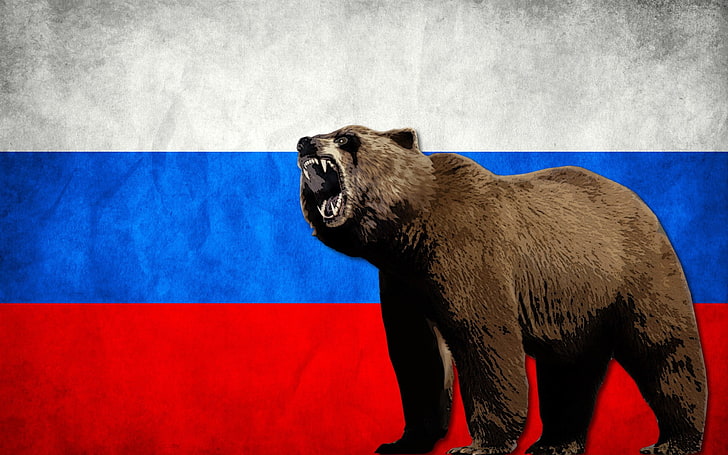1. Russian desman
Desman, either of two species of amphibious Eurasian moles that den on land but seek prey underwater instead of burrowing through soil. The protruding flexible snout is flat and grooved with a lobed tip. Desmans have tiny eyes and no external ears; the ear holes and nostrils close underwater. The forefeet are partially webbed and fringed with stiff hairs. The huge hind feet are webbed to the tips of the digits and are also fringed with hair. Claws are long, curved, and sharp. Both species have water-repellent fur that is long, soft, and dense.
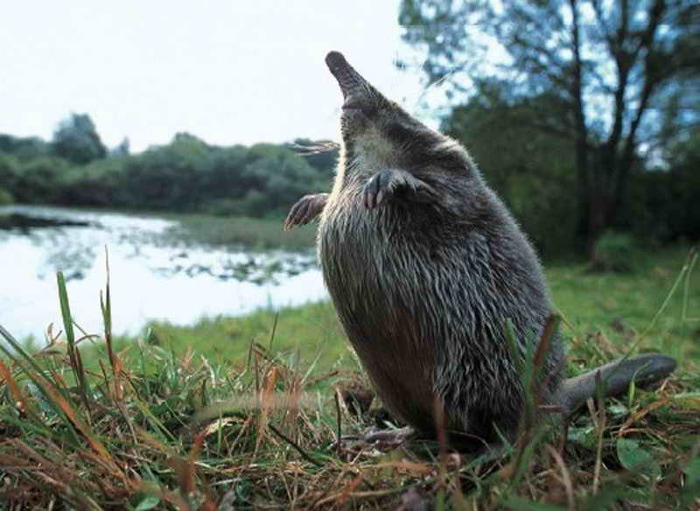
The tail of the Russian desman (Desmana moschata) is flattened horizontally and has scent glands at its base that exude a strong musky odour that envelops the animal. The Pyrenean desman (Galemys pyrenaicus) of western Europe has similar scent glands. It has a cylindrical tail, flat near its tip and fringed with stiff hairs. The Russian desman resembles a muskrat, weighing 100–220 grams (3.5–7.8 ounces), with a body about 20 cm (8 inches) long and a tail of about the same length. Upperparts are dark brown; underparts are silvery grey. The smaller Pyrenean desman weighs 35–80 grams (1.23–2.82 ounces), with a body 11–14 cm (4–6 inches) long and a longer tail (12–16 cm; 5–6 inches). It is greyish brown above and silvery-grey beneath.
The Russian desman is nocturnal and inhabits unpolluted lakes, ponds, and slow-moving streams and rivers. It swims propelled by its hind feet and tail, using its mobile proboscis-like snout to thrust and probe along the bottom for insects, crustaceans, mollusks, fish, and amphibians. Dens are constructed in stream banks and lake margins. A tunnel with an underwater entrance leads to a nest chamber above the water level. One or two litters of two to five young are usual; gestation lasts 40–50 days. The Russian desman is indigenous to southwestern Russia, Ukraine, and Kazakhstan in basins of the Don, Volga, and Ural rivers. It has been introduced into the catchments of the Ob and Dnieperrivers of northern Russia and Ukraine, respectively. Populations have declined to owe to excessive trapping for fur, water pollution, and competition for space with introduced muskrats and nutrias.
The nocturnal Pyrenean desman prefers cold, clear, and swift mountain streams and rivers at elevations from 300 to 2,200 metres (1,000 to 7,200 feet). Although awkward on land, it is an adept, fast swimmer, propelling itself primarily by its strong hind legs and feet. During the day it shelters in crevices among stones and roots in stream banks or burrows constructed by water voles. Litters of one to five young are born after a gestation of 30 days. Aquatic insect larvae and nymphs, crustaceans, and sometimes fish make up its diet. The Pyrenean desman inhabits the Pyrenees Mountains and the northern mountains of the Iberian Peninsula. It is threatened by stream pollution and other manmade alterations of its habitat.
Desmans are a subfamily (Desmaninae) of moles (family Talpidae, order Soricomorpha), which belong to a larger group of mammals referred to as insectivores. Other Eurasian species of Desmana and Galemys evolved and then went extinct during the Pliocene Epoch (5.3 million to 2.6 million years ago).
source: www.britannica.com
2. Putorana snow sheep
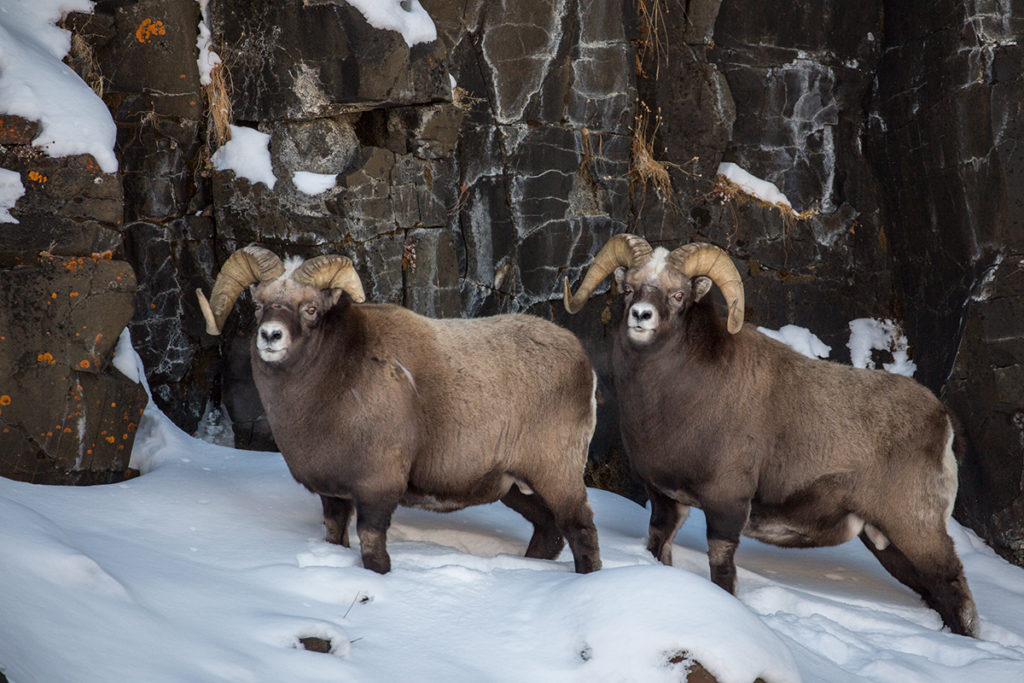
There are only five entries for the Putorana snow sheep in the SCI Record Book; three of which were taken on an unchartered expedition in August 1995, one in August 1996 and the last in July 2000. The city of Norilsk was closed in November 2001 to all non-Russians, except for Belarusians. Nickel ore is smelted on-site at Norilsk. The smelting is directly responsible for severe pollution, generally acid rain and smog. By some estimates, 1% of global emissions of sulfur dioxide come from there. Norilsk is recognized by the Russian Government as the most polluted city in the entire country. Mining and smelting ore are the major industries and Norilsk is the centre of a region where nickel, copper, cobalt, platinum, palladium and coal are mined.
3. Ross’s Gull
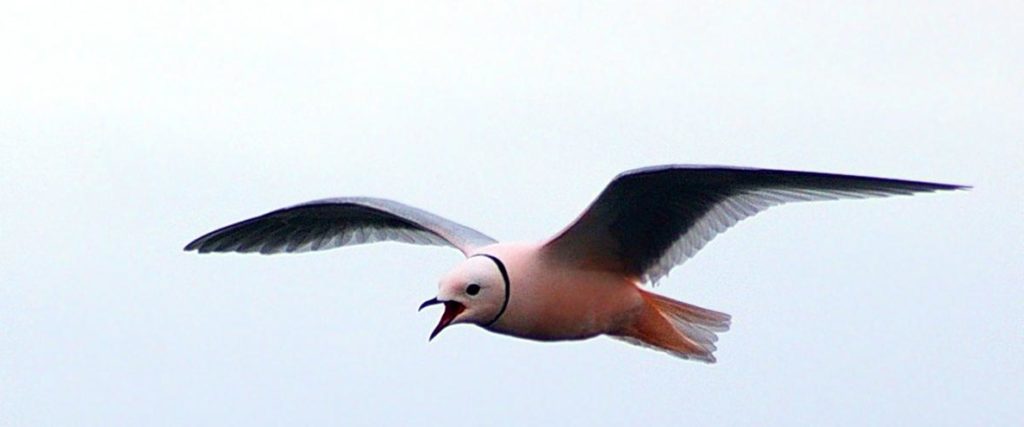
The Ross’s gull (Rhodostethia rosea) is a small gull, the only species in its genus, although it has been suggested it should be moved to the genus Hydrocoloeus, which otherwise only includes the little gull. This bird is named after the British explorer James Clark Ross. Its breeding grounds were first discovered in 1905 by Sergei Aleksandrovich Buturlin near the village of Pokhodsk in North-Eastern Yakutia while visiting the area as a judge. The genus name Rhodostethia is from Ancient Greek rhodon, “rose”, and stethos, “breast”. The specific rosea is Latin for “rose-coloured”.
This small bird is similar in size and some plumage characteristics to the little gull. It is slightly larger and longer winged than that species and has more-pointed wings and a wedge-shaped tail. Its legs are red. Summer adults are pale grey above and white below, with a pink flush to the breast, and a neat black neck ring. In winter, the breast tints and neck collar are lost and a small dark crescent develops behind the eye.
Young birds resemble winter adults, but have a dark “W” pattern on the wings in flight, like young little gulls. The juveniles take two years to attain full adult plumage.
Ross’s gull breeds in the high Arctic of northernmost North America, and northeast Siberia. It migrates only short distances south in autumn, most of the population wintering in northern latitudes at the edge of the pack ice in the northern Bering Sea and the Sea of Okhotsk, although some birds reach more temperate areas, such as north-west Europe; in February 2016 they were sighted in Cornwall and Ireland according to the BTOs ‘BirdTrack’. In North America, Ross’s gull has been spotted as far south as the Salton Sea in California, although sightings this far south are extremely rare. The summer breeding grounds are tundra with sedges, grass tussocks, dwarf willows, bushes, lichens and pools.
4. Amur lemming
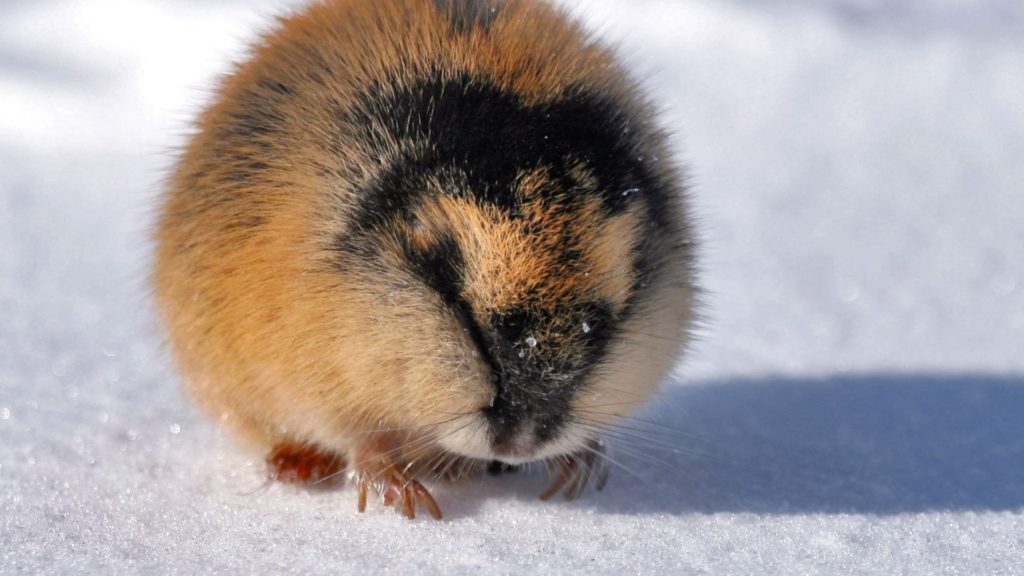
“The Amur lemming (Lemmus amurensis) is a species of lemmings found near the Amur River in Siberia. The Amur lemming is rated as Least Concern on the IUCN Red List”
So, you have a big change to meet a real one in nature.
https://en.wikipedia.org/
5. Siberian crane
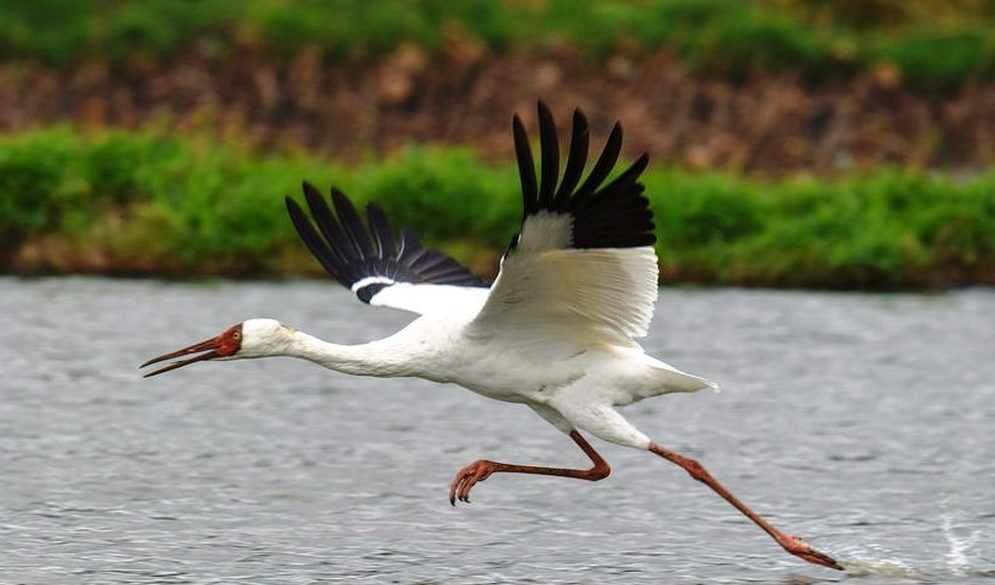
The Siberian crane (Leucogeranus leucogeranus), also known as the Siberian white crane or the snow crane, is a bird of the family Gruidae, the cranes. They are distinctive among the cranes, adults are nearly all snowy white, except for their black primary feathers that are visible in flight and with two breeding populations in the Arctic tundra of western and eastern Russia. The eastern populations migrate during winter to China while the western population winters in Iran and formerly, in India and Nepal. Among the cranes, they make the longest distance migrations. Their populations, particularly those in the western range, have declined drastically in the 20th century due to hunting along their migration routes and habitat degradation. The world population was estimated in 2010 at about 3,200 birds, mostly belonging to the eastern population with about 95% of them wintering in the Poyang Lake basin in China, a habitat that may be altered by the Three Gorges Dam. In western Siberia, there are only around ten of these cranes in the wild.
Adults of both genders have a pure white plumage except for the black primaries, alula and primary coverts. The fore-crown, face and side of the head is bare and brick red, the bill is dark and the legs are pinkish. The iris is yellowish. Juveniles are feathered on the face and the plumage is dingy brown. There are no elongated tertial feathers as in some other crane species. During the breeding season, both the male and female cranes are often seen with mud streaking their feathers. They dip their beaks in mud and smear it on their feathers. The call is very different from the trumpeting of most cranes and is a goose-like high pitched whistling Toyota. They typically weigh 4.9–8.6 kg (11–19 lb) and stand about 140 cm (55 in) tall. The wingspan is 210–230 cm (83–91 in) and length is 115–127 cm (45–50 in). Males are on average larger than females. There is a single record of an outsized male of this species weighing 15 kg (33 lb).
6. Barguzin sable
The sable (Martes zibellina) is a species of marten, a small carnivorous mammal primarily inhabiting the forest environments, of Russia, from the Ural Mountains throughout Siberia, and northern Mongolia. Its habitat also borders eastern Kazakhstan, China, North Korea and Hokkaidō, Japan. Its range in the wild originally extended through European Russia to Poland and Scandinavia. Historically, it has been hunted for its highly valued dark brown or black fur, which remains a luxury good to this day. While hunting is still common in Russia, most fur on the market is now commercially farmed.
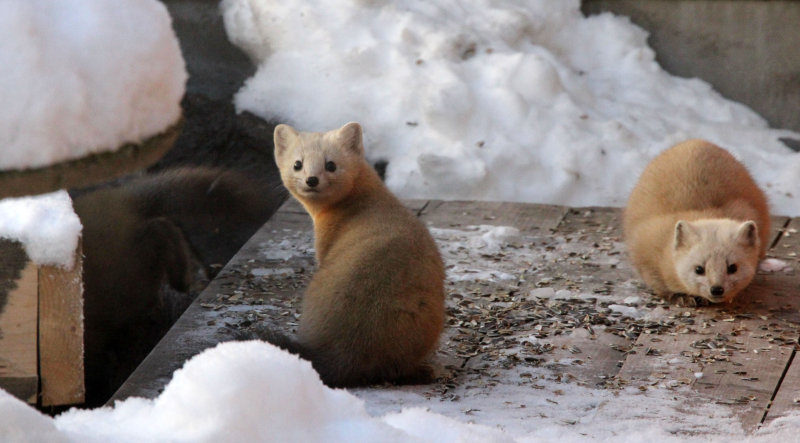
The name sable appears to be of Slavic origin and entered most Western European languages via the early medieval fur trade. Thus the Russianсоболь (Sobol) and Polish soból became the German Zobel, Dutch Sabel; the French zibeline, Spanish cibelina, cebellina, Finnish soopeli, Portuguesezibelina and Mediaeval Latin zibellina derive from the Italian form (zibellino). The English and Medieval Latin word sabellum comes from the Old Frenchsable or saible.
The term has become a generic description for some black-furred animal breeds, such as sable cats or rabbits, and the colour black in heraldry.
7. Black-capped marmots
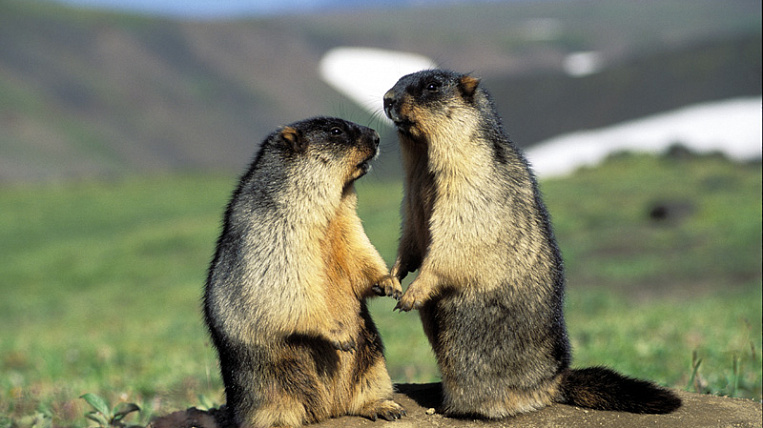
Black-capped marmots live in the cold and somewhat hostile alpine areas of eastern Siberia and Kamtchatica. Their closest relatives are probably the Alaska marmot, found in the Brooks Range. Black-capped marmots currently live in three very isolated and spatially distinct populations. A common feature in all habitats is the plethora of rocks and dirt of vegetation. They are only active about three and a half months each year and they mature slowly.
8. Spoon-billed sandpiper
This species was first described by Linnaeus in his Systema Naturae in 1758 as Platalea pygmea. It was later moved to Eurynorhynchus by Sven Nilsson in 1821. It is now classified under the calidrid sandpipers.
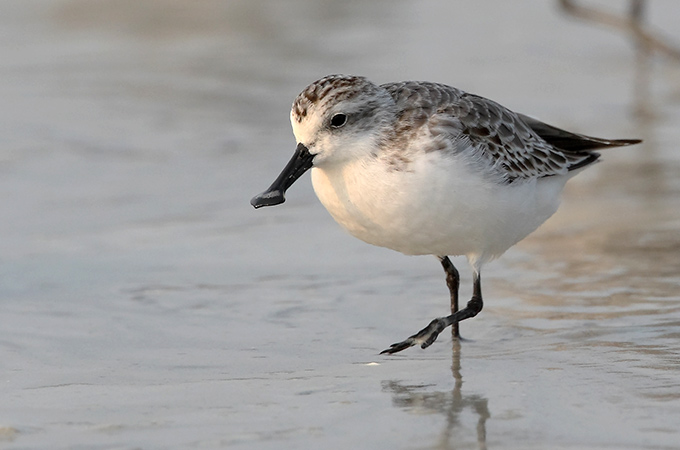
The most distinctive feature of this species is its spatulate bill. The breeding adult bird is 14–16 cm in length and has a red-brown head, neck and breast with dark brown streaks. It has blackish upperparts with buff and pale rufous fringing. Non-breeding adults lack the reddish colouration but have pale brownish-grey upperparts with whitish fringing to the wing-coverts. The underparts are white and the legs are black.
The contact calls of the spoon-billed sandpiper include a quiet preep or a shrill wheer. The song, given during display, is an intermittent buzzing and descending trill preer-prr-prr. The display flight of the male includes brief hovers, circling and rapid diving while singing.
9. Baikal seal
The Baikal seal, Lake Baikal seal or nerpa (Pusa sibirica), is a species of earless seal endemic to Lake Baikal in Siberia, Russia. Like the Caspian seal, it is related to the Arctic ringed seal. The Baikal seal is one of the smallest true seals and the only exclusively freshwater pinniped species. A subpopulation of inland harbour seals living in the Hudson’s Bay region of Quebec, Canada (lac de loups marins harbour seals), the Saimaa ringed seal (a ringed seal subspecies) and the Ladoga seal (a ringed seal subspecies) are found in freshwater, but these are part of species that also have marine populations. The ancestor of the Baikal seal migrated into Lake Baikal from the Arctic (via the Siberian ice sheet) and became isolated there.
The most recent population estimates are 80,000 to 100,000 animals, roughly equaling the expected carrying capacity of the lake. At present, the species is not considered threatened, despite hunting (both legal and illegal) and pollution of the lake.
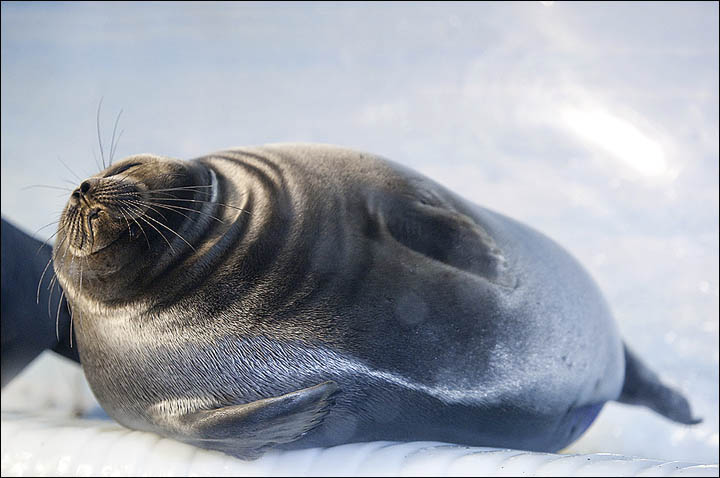
The Baikal seal lives only in the waters of Lake Baikal. It is something of a mystery how Baikal seals came to live there in the first place. They may have swum up rivers and streams or possibly Lake Baikal was linked to the ocean at some point through a large body of water, such as the West Siberian Glacial Lake or West Siberian Plain, formed in a previous ice age. The seals are estimated to have inhabited Lake Baikal for some two million years.
The areas of the lake in which the Baikal seals reside change depending on the season, as well as other environmental factors. They are solitary animals for the majority of the year, sometimes living kilometres away from other Baikal seals. In general, a higher concentration of Baikal seals is found in the northern parts of the lake, because the longer winter keeps the ice frozen longer, which is preferable for pupping. However, in recent years, migrations to the southern half of the lake have occurred, possibly to evade hunters. In winter, when the lake is frozen over, seals maintain a few breathing holes over a given area and tend to remain nearby, not interfering with the food supplies of nearby seals. When the ice begins to melt, Baikal seals tend to keep to the shoreline
10. Orlov Trotter
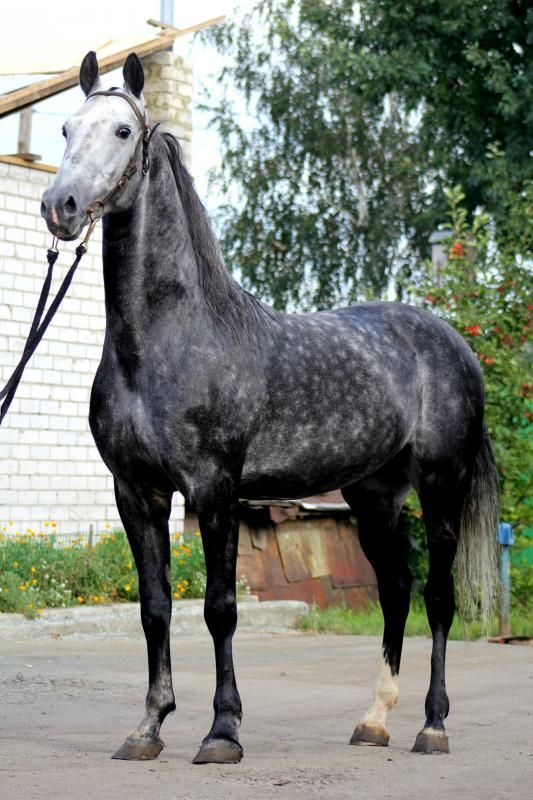
The Orlov Trotter is a horse breed with a hereditary fast trot, noted for its outstanding speed and stamina. It is the most famous Russian horse. The breed was developed in Russia in the late 18th century by Count Alexei Orlov at his Khrenovskoy stud farm near the town of Bobrov (Voronezh Guberniya). The Orlovs emerged as the result of crossing various European mares (primarily of English, Dutch, Mecklenburg, and Danish breeding) with Arabian stallions.
During the 19th century, Orlov trotters were used mainly for riding and harness racing by Russian nobility. They were valued for their beauty and elegance combined with the ability to work hard. They were also used for the improvement of other Russian horses. When harness racing became widespread at the end of the century, the Orlovs faced intense competition from American-developed Standardbreds, who are generally recognized as less refined but faster than Orlov trotters. Eventually, Standardbred stallions were crossed with Orlov mares and a new breed, the Russian Trotter, appeared. The possibility of the complete extinction of the Orlovs was a concern in the 20th century because of crossbreeding and the Sovietdisregard of horse-raising. However, the breed survived, and today fifteen stud farms in Russia and Ukraine raise pure-blooded Orlov Trotters.
The land that became Orlov’s Khrenovsky stud farm was given to him by Catherine II (Catherine the Great) as a reward for his participation in the coup d’etat which brought her to the throne. The buildings were constructed by Giovanni Giliardi. The original estate was very large; the modern Khrenovsky stud area is fifteen times smaller than it was before the Bolshevik revolution.
The ancestor of all Orlov Trotters was the purebred grey Arabian stallion Smetanka. Orlov bought him in Turkey for the enormous sum of 60,000 rubles. Although he died the next year, he lived to sire five offspring. Among others, he was crossed with Isabelline, a Danish mare from the Frederiksborg royal stud-farm, who foaled a stallion that was named Polkan (1778–1793).
Polkan was crossed with a Dutch mare which, in 1784, produced the grey stallion Bars I (1784–1808), considered the first Orlov trotter. He was 162.5 cm high at the withers which made him taller than most contemporary trotters, possessed a fast trotting gait and featured the beauty and noble bearing which would later distinguish the newly created breed. For seventeen years Bars, I was crossed with different mares and sired eleven stallions that carried his distinguishing characteristics. The emergence of the breed was the result of a thorough and elaborate selection process. About 3,000 horses kept at the stud were involved. Unlike many other Russian nobles who were fond of horse-raising, Orlov was a professional breeder who is also credited for creating some seventy different animal breeds including the Russian wolfhound.
Orlov was very protective of his bloodstock and would sell only geldings (castrated stallions). Even when Tsar Alexander I asked Orlov to sell him several stallions, Orlov only agreed to sell geldings. This rule was maintained for twenty years after Orlov’s death. Later, when the Khrenovsky stud farm belonged to the Russian Crown, Trotters were then openly sold to private stud-owners.
11. Siberian tiger
Siberian (or Amur) tigers are the world’s largest cats.
Population Range: They live primarily in eastern Russia’s birch forests, though some exist in China and North Korea. Though their northern climate is far harsher than those of other tigers, these animals have some advantages. Northern forests offer the lowest human density of any tiger habitat and the most complete ecosystem. The vast woodlands also allow tigers far more room to roam, as Russia’s timber industry is currently less extensive than that of many other countries.
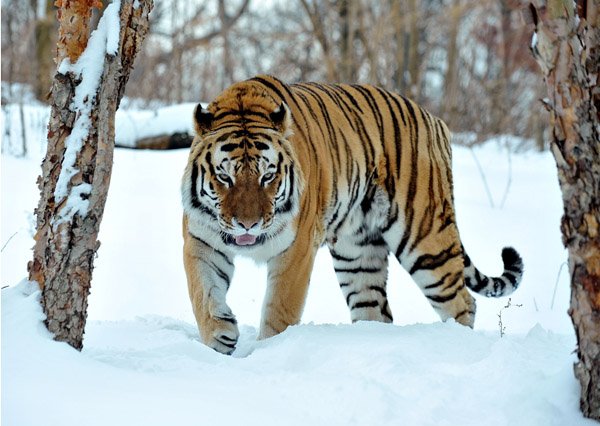
Threats to Survival: Tigers are the largest of all wild cats and are renowned for their power and strength. There were once nine tiger subspecies, but three became extinct during the 20th century. Over the last hundred years, hunting and forest destruction have reduced overall tiger populations dramatically. Tigers are hunted as trophies and also for body parts that are used in traditional Chinese medicine. All six remaining tiger subspecies are threatened, and many protection programs are in place. Poaching is a reduced—but still very significant—threat to Siberian tigers.
Hunting: Tigers live alone and aggressively scent-mark large territories to keep their rivals away. They are powerful hunters that travel many miles to find prey, such as elk and wild boar, on nocturnal hunts. Tigers use their distinctive coats as camouflage (no two have the same stripes) and hunt by stealth. They lie in wait and creep close enough to attack their victims with a quick spring and a fatal pounce. A hungry tiger can eat as much as 60 pounds in one night, though they usually eat less.
Despite their fearsome reputation, most tigers avoid humans; however, a few do become dangerous maneaters. These animals are often sick and unable to hunt normally or live in areas where their traditional prey has vanished.
Reproduction: Females give birth to litters of two to six cubs, which they raise with little or no help from the male. Cubs cannot hunt until they are 18 months old, and remain with their mothers for two to three years when they disperse to find their territory.
source: www.nationalgeographic.com
12. Steller’s sea eagle
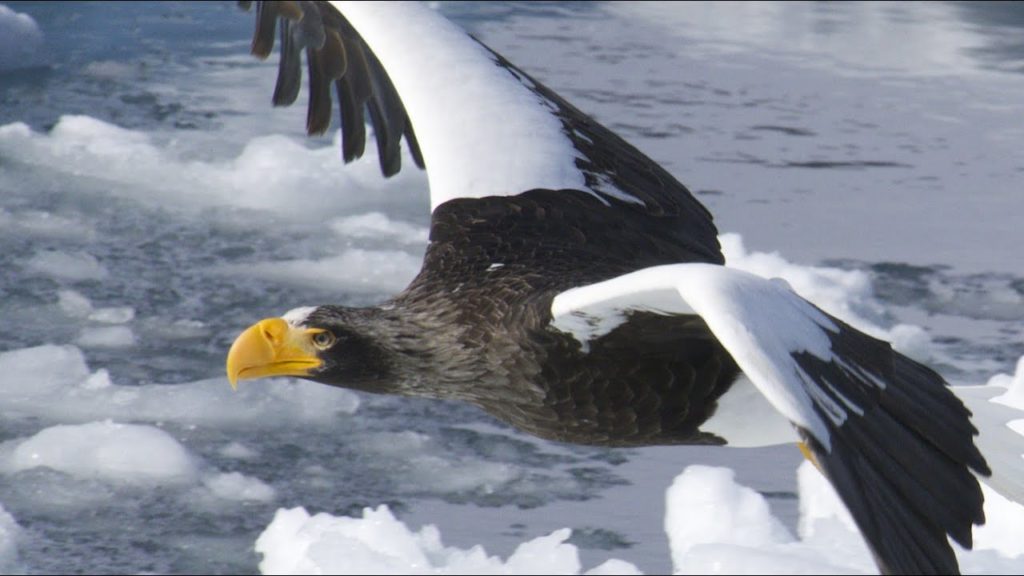
These very large, powerful eagles are also striking in appearance. They are dark but dramatically coloured with whitetail, shoulders, rump, thighs and forehead.
Habitat and Range
These eagles are believed to breed only in far eastern Russia, along with the coasts and surrounding islands of the Sea of Okhotsk and the Bering Sea. They are most common on the Kamchatka Peninsula.
Each winter, many Steller’s sea eagles migrate from their breeding grounds to Japan, and a few reach Korea or even farther afield. Other individuals do not migrate, but simply move to open water as winter approaches.
Hunting and Diet
Open water provides these eagles with their main food sources along coastlines and lakes. In their breeding grounds, Steller’s sea eagles subsist largely on salmon, and they both hunt and scavenge for this resource. Annual salmon runs provide an enormous bounty and Steller’s sea eagle nests are typically located near coasts and rivers where these fish appear en masse.
These birds of prey hunt from a perch or from flight by diving and clutching prey in their talons. They also stand in shallow water or on the ice and grab passing fish when the opportunity arises. Like other eagles, Steller’s also steal food from other birds.
In Japan, Steller’s sea eagles feast on cod. In addition to fish, they eat crabs, shellfish, squid, small animals, ducks, gulls, and carrion.
Population
Steller’s sea eagles do not occur in large numbers, but their populations appear to be stable. Their feathers were once highly prized, but today these magnificent birds are protected throughout their range. They are especially revered in Japan, where they are known as O-washi.
source: www.nationalgeographic.com
13. Kamchatka brown bear
Brown bears are one of the most widely distributed large carnivores in the world. The Kamchatka peninsula was once entirely populated with brown bears, and in remote protected areas is still home to the highest recorded density of brown bears on Earth. Increasing human access, through road development to expand mining and mineral exploration, is fragmenting the once continuous bear population, and Kamchatka brown bears are now becoming rare in some regions close to human settlements. Population estimates for the entire Kamchatka peninsula range from 10,000-14,000 bears in an area about the size of California. Population counts for the region are based largely on the casual observations of hunters and forest workers and are scientifically questionable. More than a decade has passed since the last aerial survey of the region, and there is a desperate need to redefine survey methods to monitor the long term trends in the bear population.
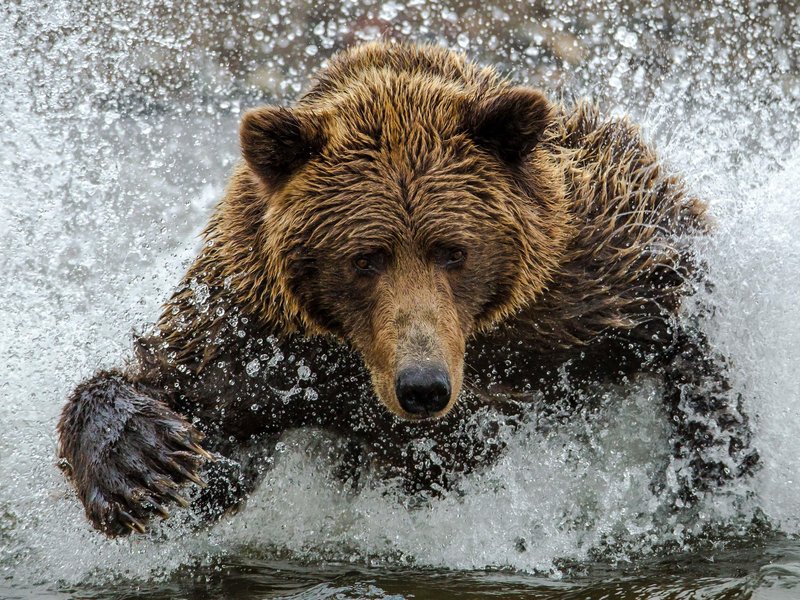
Physical Description
Male Kamchatka brown bears can reach a weight of 700 kilograms and are among the largest bears in the world. Their large physical size is a result of their access to rich food sources like salmon, pine nuts and berries. Maintaining body weight is crucial to surviving the long period that bears spend sleeping in their winter dens (up to 6 months on Kamchatka).
Reproduction and Life Span
Female brown bears in Kamchatka can begin to reproduce as early as 4 years of age and typically have litters of 2-3 cubs. WCS research has shown that some female bears with cubs do not approach salmon streams, to avoid risking their cubs being killed by another bear. By staying away from the salmon streams the females reduce the risk of cub mortality but are also forced to survive on less rich food sources. Gaining enough weight to survive the winter is critical for female brown bears and their offspring. Cubs are born in the dead of winter in dens where the female is hibernating. Pregnant female bears that enter the den poorly nourished will often not be able to support their offspring, and the pregnancy will end before the birth of the cubs. The size of male brown bears is related to their social status and access to food and mates. Female bears must be induced into estrus, which means a male bear may have to follow a female bear for weeks until she is receptive to mating. During this time the male bears must fight off other male suitors. Females can produce offspring from different males in a single litter.
Home Range
The area that a bear requires to fulfil all of its life requirements varies depending on habitat type and food sources available. In areas very rich in salmon, WCS research has shown that bears will maintain a home range as small as 12 sq km over the entire year. In areas where salmon and other food sources are scarce, however, home ranges can be as large as 1100 sq km. Data from GPS-collared bears showed that bears made movements of up to 65 km and crossed Kamchatka’s central mountain range to access different salmon runs, crossing into different hunting leases and even leaving protected areas.
Habitat
Kamchatka has some of the best brown bear habitats in the world. The highest concentrations of bears occur along streams during salmon spawning. Dense dwarf Siberian pine swales, as well as expansive berry tundras, can be rich feeding grounds for bears. Coastal sedge meadows and lush vegetation fed by heavy rainfalls are a bear “salad bar” when less rich food sources are available. In the fall bears in Kamchatka will usually excavate dens at higher elevations on south-facing slopes.
Food sources
Salmon including Pink, Sockeye, Coho, Chum, King, Cherry as well as char. Dwarf Siberian pine nuts, blueberries, crowberries, cranberries, mountain ash berries and others. Bears also feed on a wide variety of vegetation usually in the early summer. In some regions bear will hunt sea otters or be fortunate enough to find dead sea mammals like seals and even whales along the shore.
14. Amur leopard
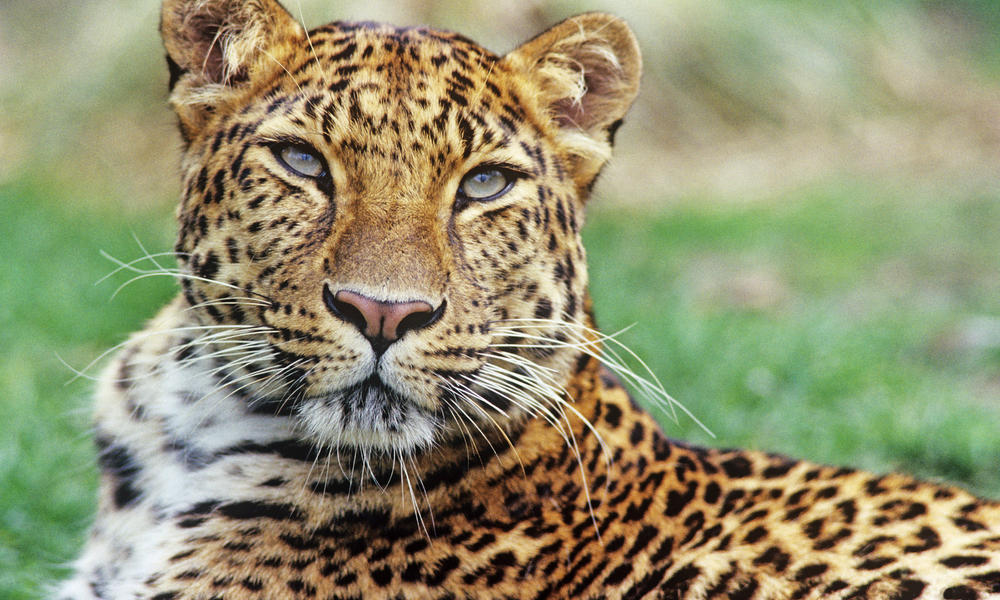
Description: The Amur leopard is adapted to the cool climate by having thick fur which grows up to 7.5 cm long in winter. For camouflage in the snow, their coat is paler than other leopard subspecies. The Amur leopard’s rosettes are widely spaced and larger than those seen on other leopards.
Weight: Males generally weigh 32-48 kg, but can weigh up to 75 kg. Females are smaller than the males at 25-43 kg.
Breeding: Females first breed at an age of 3-4 years. After a gestation period of around 12 weeks, cubs are born in litters of 1-4 individuals, with an average litter size of just over 2. The cubs stay with their mother for up to two years before becoming fully independent. Amur leopards in zoos show some evidence of breeding seasonality with a peak in births in late spring/early summer.
Longevity: In the wild, leopards live for 10-15 years and they may reach 20 years in captivity.
